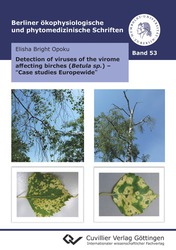| Departments | |
|---|---|
| Book Series (96) |
1378
|
| Nachhaltigkeit |
3
|
| Gesundheitswesen |
1
|
| Humanities |
2364
|
| Natural Sciences |
5406
|
| Mathematics | 229 |
| Informatics | 319 |
| Physics | 980 |
| Chemistry | 1363 |
| Geosciences | 131 |
| Human medicine | 243 |
| Stomatology | 10 |
| Veterinary medicine | 108 |
| Pharmacy | 147 |
| Biology | 835 |
| Biochemistry, molecular biology, gene technology | 121 |
| Biophysics | 25 |
| Domestic and nutritional science | 45 |
| Agricultural science | 1004 |
| Forest science | 201 |
| Horticultural science | 20 |
| Environmental research, ecology and landscape conservation | 148 |
| Engineering |
1793
|
| Common |
98
|
|
Leitlinien Unfallchirurgie
5. Auflage bestellen |
|
Advanced Search
Detection of viruses of the virome affecting birches (Betula sp.) - "Case studies Europe-wide" (Volume 53) (English shop)
Elisha Bright Opoku (Author)Preview
Extract, PDF (1.4 MB)
Table of Contents, PDF (160 KB)
Over the years, birches keep declining at various locations in Europe especially in cities,
parks streets as well as forest due to biotic and abiotic stress factors.
The decline of birches is characterized by die-back of twigs, branches, and can lead to the
loss of tree crown, and finally to death of the tree. Virus-suspected leaf symptoms were
observed on declining birches, which were attributed to Birch leaf roll
disease (BLRD). Investigations from this thesis give an impression
that, the birches can be infected by more virus species than ever assumed. The birch has a complex virome than expected and the decline cannot be attributed not
just to a particular virus. Modern techniques, such as high-throughput sequencing (HTS),
gave a comprehensive identification of possible viral pathogens present in the birch genome.
In 2014, sequences of a previously unknown viruses could be discovered in symptomatic leaf
samples of the genus Betula. Investigations of the prevalent birch
viruses (BLRaV, CLRV, BiCV and ApMV) led to discovery of new viral signatures (e.g.
Birch capillovirus, Birch caulimovirus, Birch benyvirus and Birch idaeovirus) in leaf samples
from different areas in Europe. This indicates a wide distribution of these viruses as discussed
in this thesis. The sequences obtained from complex virome RNA-Seq were about 70 %
similar to known plant viruses. With the aid of the high-throughput sequences, RT-PCRbased
detection systems for newly discovered viruses have been developed. Furthermore, the
genome of these new viruses was to be further characterized and first results on the
dissemination of them were presented.
| ISBN-13 (Hard Copy) | 9783736977532 |
| ISBN-13 (eBook) | 9783736967533 |
| Final Book Format | A5 |
| Language | English |
| Page Number | 188 |
| Lamination of Cover | matt |
| Edition | 1. |
| Book Series | Berliner ökophysiologische und phytomedizinische Schriften |
| Volume | 53 |
| Publication Place | Göttingen |
| Place of Dissertation | Berlin |
| Publication Date | 2023-03-15 |
| General Categorization | Dissertation |
| Departments |
Biology
Biochemistry, molecular biology, gene technology Plant production |
| Keywords | Birke, birch, Birch leaf-roll associated virus, Afrikanisches Maniokmosaikvirus, African cassava mosaic virus, Apfel-Mosaik-Virus, Apple mosaic virus, Arabis-Mosaik-Virus, Arabis mosaic virus, Birken-Carlavirus, Birch carlavirus, Birken-Idaeovirus, Birch idaeovirus, Nukleotidabfrage, nucleotide query, Grüne Reisblatthüpfer, Green rice leafhoppers, Endogenous pararetrovirus, Phytomedizin, Bewegungsprotein, movement protein, biotische Stressfaktoren, abiotische Stressfaktoren, biotic stress factors, abiotic stress factors, Birkenblattrollkrankheit, Pflanzenviren, Betula-Virom |








